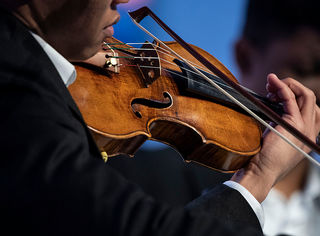Education
Virtuosity: Virtue or Vice?
Research is learning more about a performer's “license to thrill”
Posted March 4, 2019

Virtuoso musical performance. It’s the stuff of Hollywood movies: an extraordinarily devoted musician fights through adversity to give an amazing performance that wows everyone, including those who previously doubted or even impeded the musician’s progress. It’s David Helfgott tackling the piano works of Liszt and Rachmaninoff in the 1996 Oscar-nominated movie Shine (Helfgott portrayer Geoffrey Rush won the Oscar for best lead actor). More recently, in the 2014 Whiplash, it’s drumming talent Andrew Neyman (played by Miles Teller) subjecting himself to any hardship that advances his performance skills, even the abusive tutelage of elite conservatory teacher Terence Fletcher (another best actor Oscar winner J. K. Simmons).
Before modern Hollywood filmmakers turned to virtuosi to find Oscar buzz, these musical marvels were popular guests on the Ed Sullivan Show. In the 1950s and 60s, virtuoso performers included violinists Itzhak Perlman and Michael Rabin, pianists Roger Williams and Alan Kogosowski, and trumpeters Dizzy Gillespie and Al Hirt. And well before the advent of motion picture technology, musical virtuosi were the stuff of legends. Performances of 19th century violinist Niccolò Paganini were so astounding, people thought he must be possessed by the devil. Similarly, when the guitar technique of bluesman Robert Johnson became inconceivably good—Rolling Stones guitarist Keith Richards, upon hearing a Johnson recording, thought there were two guitarists playing (Bockris, 2003, p. 43)—the legend of his crossroads deal with the devil was born.
Jaw-dropping performance is a time-tested way to bring applauding audiences to their feet. As much as music fans love having their emotions moved by a performer’s musical expressivity, there just something irresistible about witnessing a live display of technical wizardry onstage. It’s can be thrilling, awe-inspiring, even otherworldly. In this way, it’s easy to understand why people—especially those of the 19th century—would turn to be supernatural to explain virtuosity.
Supernatural phenomena was not one of the explanations explored in a recent special issue of the research journal Musicae Scientiae. The collection of research articles did, however, offer interdisciplinary consideration of virtuosity that included perspectives from psychology, musicology, and cognitive science.
The popular appeal of virtuosity can be understood, from a psycho-sociological perspective, as a form of the idolization phenomenon (Parncutt, 2018). Throughout human history, idol worship has been present in the subcultures of acting, music, sports, politics, and of course, religion. The principal ways that fans orient toward their idols is to know a lot about them, revere them, empathize with them, imitate them, and supportively attend their public appearances. A fan’s attachment to an idol can produce an imagined relationship with him or her. Of course, identification can give way to obsession, and fans can find themselves in the realm of celebrity worship syndrome.
Absorption and feelings of wonder contribute to idolization, which is likely another reason musical virtuosity has often been attributed to supernatural factors. The transcendental emotions elicited by music can be very similar to those that people feel in religious experiences. Feelings of awe, admiration, and appreciation for the sublime produce intensely powerful experiences for audience members at a virtuosic performance.
Many musicians seem to understand this and include within their very definition of virtuosity the need for “musical flair and showmanship” (Ginsborg, 2018). Some simply call it “showing off.” And what virtuosic performers are expected to show off is supreme technical skill. What’s more, that technique must be carried out with ease, or as one scholar called it, the “masque of nonchalance” (Royce, 2004, p. 18, as cited in Ginsborg, 2018).
While recognizing the need for virtuosity to be “magical” for audiences, many musicians now understand their need to go behind the magic, as it were. After all, entertainers who perform as magicians on stage are in reality better labeled as illusionists. In a recent survey of classically-trained musicians, an overwhelming majority attributed virtuosic performance to hard work through practice rather than any natural gift or innate talent.
From past research on deliberate practice, cognitive psychology has revealed that acquiring physical performance skills is accompanied by the building of underlying cognitive skills. This is the case with the skills of virtuosity. A team of researchers studying music practice addressed how a virtuosic performance must have a high level of fluency and at the same time avoid relying on mindlessly automatic motor sequences that suggest a lack of any emotionality to audiences (Lisboa, Demos, & Chaffin, 2018). They concluded that modern virtuosic performance preparation involves musicians practicing the thoughts and feelings they want to convey and linking them to the actions that produce their performed music. Other research supports this approach, suggesting that exceptional music performance requires a mental virtuosity, by which performers quickly and constantly adapt their attention during music-making to mindfully focus on various aspects of performance. Their focus on any one aspect, though momentary, is nonetheless immersive (Stachó, 2018). Executing both flexibility and depth of focus simultaneously requires much thoughtful practice guided by careful goal-setting and strategy use.
Clearly performance virtuosity in music is a decidedly cognitive undertaking. It should serve as a reminder to musicians that motor skills are better called psychomotor skills and “muscle memory” (which is now commonly talked about in artistic and athletic performance circles) does not reside people’s muscles, but in their minds (where memory is stored).
In the past, virtuosity was almost exclusively defined by fast and brilliant displays of technical facility. In fact some referred to it as “mere” virtuosity and contrasted it to more meaningful expressive musicianship. For example, 19th century piano virtuoso and composer Robert Schumann once wrote that virtuosity “contributed but little to the benefit of the art” of music which he likened to expressive poetry (Stefaniak, 2016, as cited in Ginsborg, 2018). In the same vein, Romantic era maestro Richard Wagner asserted that “true great artists owe their reputation to their moving execution” of noble musical works, but the virtuoso “entrances purely for himself: here runs, there jumps; he melts, he pines, he paws and glides, and the audience is fettered to his fingers” (Wagner 1840/1898, as cited in Ginsborg, 2018).
Recent research on the meaning of virtuosity among musicians has suggested that traditional conceptions of traditional conceptions of virtuosity are giving way to newer ones that include musical expressivity. In this new definition of virtuosity, technical prowess is considered a tool in the service of expressing musical ideas (Ginsborg, 2018). For better or worse, this new definition equates not to changed expectations but to added expectations:
Being able to play anything perfectly, fluently and safely within current performance style…is simply a necessary starting-point before other kinds of virtuosity come into play. And so the modern musician is required to be both human and superhuman, expressive and brilliant, moving and thrilling; no longer one at the expense of the other, but both on every occasion. (Leech-Wilkinson, 2018, p. 559)
With virtuosity expectations seemingly rising in today’s musical world, it is no wonder that some researchers have directed their attention to the anxiety that can characterize the life of a virtuoso performer. Virtuosity usually involves a high level of competition, whether it’s vying against other musicians for the relatively few performer positions, or competing with one’s own standard of perfection. Holding the label of virtuoso essentially demands that performers do the impossible and even then, they are often expected to do it more thrillingly than anyone else.
Given what has long been known about virtuosity, as well as what emerging research is indicating about it, it is reasonable to wonder whether virtuosity—the public’s demand for it and performers’ pursuit of it—might do more harm than good. In closing the special issue of Musicae Scientiae, musicologist Daniel Leech-Wilkinson straight-forwardly addressed “The Danger of Virtuosity,” eloquently asking whether modern virtuosity is worth it:
Classical music then, in training and practice, is bedeviled by problems of conformity; conformity to the imagined wishes of the dead composer, conformity to current norms (minimising paid rehearsal), and to the need, if one wishes to be employable, to sound the values of the musical state more thrillingly and persuasively than one’s competitors. With this impossible demand comes stress and other kinds of performance-related-ill-health.
Perhaps the best advice to give musicians interested in acquiring virtuosic performance skills for themselves is to approach the endeavor with their eyes wide open. Achieving virtuosity requires much practice, and as I shared in a previous post, there are a number of good reason why musicians should consider practicing less and not more. Being a virtuoso seems to offer powerful musical and emotional rewards to performers, but becoming a virtuoso likely comes at a considerable cost.
Copyright 2019 Robert H. Woody
Source of image: Flickr Creative Commons
References
Bockris, V. (2003). Keith Richards: The Biography. New York: Da Capo Press.
Ginsborg, J. (2018). “The brilliance of perfection” or “pointless finish”? What virtuosity means to musicians. Musicae Scientiae, 22(4), 454–473.
Leech-Wilkinson, D. (2018). The danger of virtuosity. Musicae Scientiae, 22(4), 558-561.
Lisboa, T., Demos, A. P., & Chaffin, R. (2018). Training thought and action for virtuoso performance. Musicae Scientiae, 22(4), 519-538.
Parncutt, R. (2018). Mother–infant attachment, musical idol worship, and the origins of human behavior. Musicae Scientiae, 22(4), 474-493.
Royce, A. (2004). Anthropology of the performing arts: Artistry, virtuosity, and interpretation in a cross-cultural perspective. Walnut Creek, CA: Altamira Press.
Stachó, L. (2018). Mental virtuosity: A new theory of performers’ attentional processes and strategies. Musicae Scientiae, 22(4), 539-557.
Stefaniak, A. (2016). Schumann’s virtuosity: Criticism, composition and performance in nineteenth-century Germany. Bloomington, IN: Indiana University Press.
Wagner, R. (1898). The virtuoso and the artist (W. Ashton Ellis, Trans.). The Wagner Library. Retrieved from http://users.belgacom.net/wagnerlibrary/prose/wagvirtu.htm (Original work published 1840).




